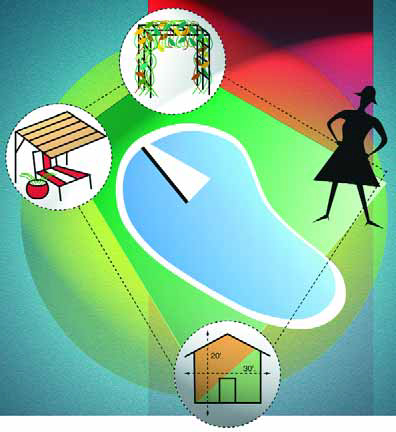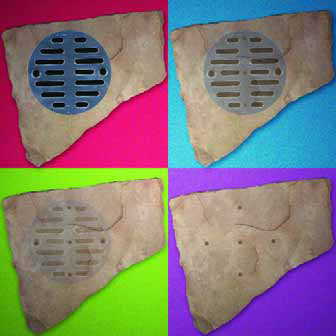Landscape, Plants, Hardscape & Decks
It's the little things that often make the biggest difference in creating beautiful spaces within gardens or near watershapes. A well-articulated retaining wall here, a clever treatment of a stone footpath there or the perfect placement of a stone stairway can, at various points, lend variety, balance and even a sense of antiquity to the work. In the first installment of this series of articles on classic uses of stone in gardens and watershapes, we began with an overview of stones set among plantings and used as simple structures in some of the world's most beautiful
More and more of my clients are interested in including edible plants in their gardens. They're into cooking, great food, fine wine and entertaining, and they appreciate the special flavors that come when they grow and harvest their own edibles. It's incredibly satisfying to walk out into one's own garden and pick fruits or vegetables or herbs. Not only do these edibles taste better than store-bought produce, but any gardener can be reasonably sure that the foods they grow are free of pesticides and other undesirable contaminants. No matter what
The ancient Celts transported huge slabs of stone over long distances to create religious circles at Stonehenge and Avebury. The Romans used stone to build their aqueducts. From the pyramids of Egypt to the Acropolis in Athens, from the Great Wall of China to the great castles of Europe, stone has been the raw material of choice for our greatest and most enduring structures. Through the ages, stone has been a well-used material because it is both durable and readily available. It's hard to find a town in Europe without walls constructed of local stone, and all you need do is drive through
Summer is arriving, and those 90-degree-plus days are coming with it. Your clients are thrilled to have their watershapes to cool off in, but they can't spend all their time in the water! I've discussed shade structures and shade trees before, and it's an important feature to discuss with any clients whose yard you are designing. But there's more to shade than what you do overhead, and you need to discuss what you'll be planting in those shaded areas. There are two problems here. For the most part, people don't know what to plant in the shade - nor do they
Contrary to the impression that might be given by the headline, this isn't an article about building arbors that are safe. Rather, it's about how you can protect your clients and their guests from the sun by building beautiful structures in their yards. (Safety is part of the discussion, too, but not its focus.) I bring this up because many clients put piles of money into building spectacular pools but fail to give much thought to their surroundings. That's a shame, because those surroundings almost certainly will be seen much more than the pools will be used in the course of the average year. Several things need to be
There's never been much of a tradition in this country when it comes to beautiful stonework, especially when it comes to flat stone surfaces. What you usually see is the same few stone types used over and over again in the same sorts of applications. To see a contrasting heritage, just travel in Europe and some parts of Asia, where you'll see a far greater variety of flat stone used in creative ways to create pathways, walls, decks, patios and a host of architectural features, including pilasters and finials. Of course, the Old World had a long head start on us, but even so, we've been slow in the New World to catch up with the masonry and quarrying trades as they've been practiced abroad for centuries. Fortunately, that's starting to change. My firm, Malibu Stone & Masonry of Malibu, Calif., supplies stone (flat and otherwise) to a host of contractors, landscape architects and designers. What we're seeing is a two-stage process: Professionals are surprised
When I meet with clients for the first time, we talk a lot about what style, design, color and other elements appeal to them. We also talk about whether they want a low-maintenance garden, or whether they want to put a lot of work into their own high-maintenance yard. Consistently, however, I find that people do not even remotely understand what I mean by "maintenance." I hear things like, "I don't need a sprinkler clock," or, more truthfully, "I don't want to spend the money on a sprinkler clock" - and I immediately
You'd think that having lousy-looking deck drains was inescapable, given that about 99.9% of them look like a thing you'd find in your shower. Whether you're using PVC or brass grates, they disrupt the surface of any decking material and to my way of thinking are an unnecessary eyesore - nearly criminal when they interrupt the look and texture of a beautiful expanse of stone. It just doesn't make any sense to draw that much attention to the drains. That's why I decided to develop a deck-drain detail that doesn't break up the visual lines of the deck. It's extremely simple - and it's something you can
I feel like I'm working backward: First, I told you about a gargantuan water lily and its very specific requirements, then I offered a more general look at water lilies that will thrive in almost any pond. Now I'm going to give you some ideas and tips for designing with all types of water plants. It might have been more logical to approach things the other way around, but the important thing is that we're ready to complete the package and talk about ways of incorporating lilies and water plants of other sorts into beautiful, overall planting designs. As always, I will avoid getting too specific with recommendations. Instead, I'll stick to basic






















